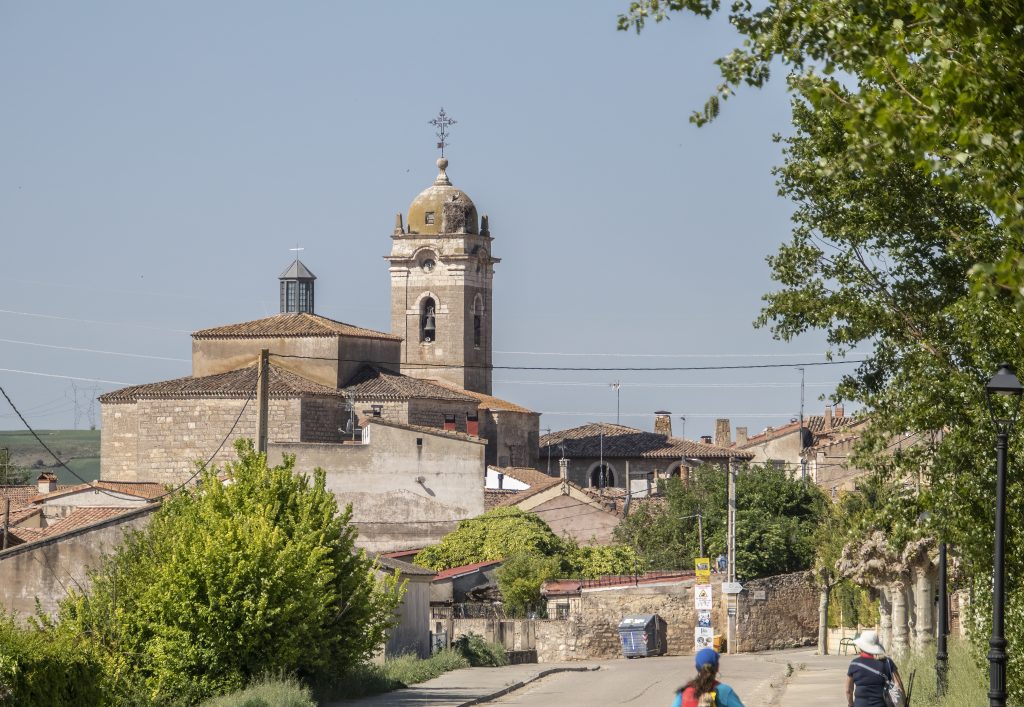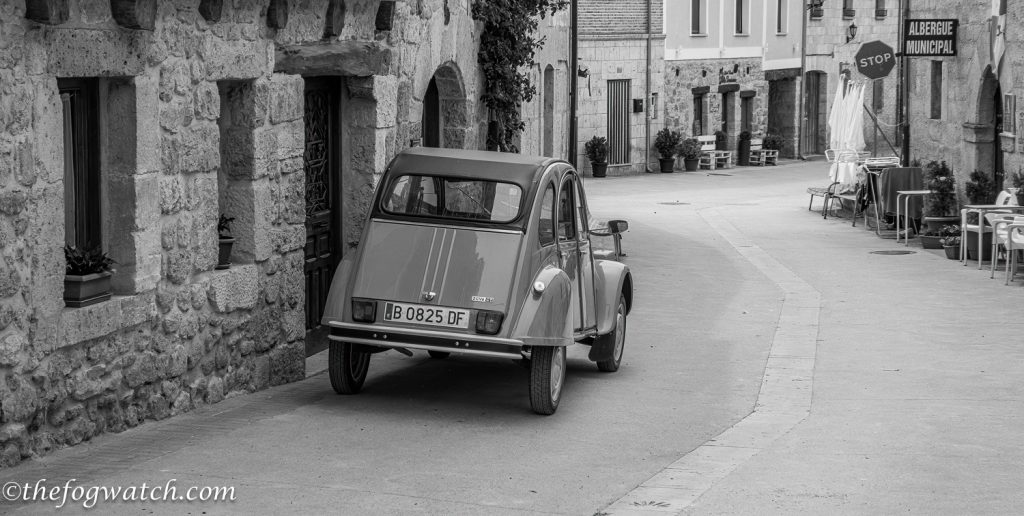Sunrise
Bound for Hornillos, I woke, still tired after a restless night, and was up by 0630am. We walked down to La Fuente for breakfast and by 7.30am we were out on the road. We had a good conversation with Jen from Lancashire UK. As we left Rabe, we saw a poster memorialising the pilgrim Denise murdered in 2015. And yes the killer was caught and given a long jail sentence.
The poster brought to mind the many forum comments about safety on the Camino, especially for solo female walkers. The Camino is still one of the very safest paths to travel. Pilgrims do look out for each other. And especially on the Frances route, you are usually within sight of one or more pilgrims, even on the Meseta. And there is a special police force called the Guardia Civil specifically established to protect the pilgrims.

As the Sun rose, we saw majestic windmills lazily rotating in the light breeze. It twirls like a high-tech ballet. Birds whirled in and out of the slowly rotating arms. Perhaps they caught the morning insects disturbed by the airflow. The birds easily avoided the elegantly curved arms of the windmills.
We walk through rolling wheat and barley fields and the track is well maintained. The landscape resembles the rolling countryside of the mid-north of South Australia where I finished my schooling.

Camino thoughts
I reflected on yesterday’s Spanish graffiti which translated as ‘There is no Way, the Way is made by walking.’ Aristotle said something similar, in latin translated as ‘Solvitur Ambulando’ ‘It is solved by walking’. It derives from his habit of pacing up and down while thinking.
Perhaps the rhythm of walking or the patterning of movement helps the thought process. Or perhaps the rhythm of walking allows the subconscious to take over, confident that the body is engaged in monotonous activity. This leaves the mind free to wander and indeed wonder at the vast landscape around us.
On walking
Walking is travel reduced to the pace of the body. Through walking we take in and process the landscape around us. And that includes the details. It is like sketching, where you take the time to observe the details, and the overall composition. So too with walking. We walk, not to a destination, but to our self-knowledge. Once you realise that it’s not about an external destination, walking itself is pretty straightforward. The landscape opens out in its expanse, and in four or five hours we reach our physical destination for the day.

On the Meseta, the most important destination lies within our own thoughts. Some people screen out their thoughts with music. Do they they miss the sussuration of the wind among the barley? Do they hear the momentary crunch of the bicycle wheels the instant the cyclist is upon them, their cheery ‘Buen Camino’ dopplering into the distance, leaving them startled and shaking. The surprise can unsettle your reverie. At the end of the day, it is all part of the Camino story — a thousand-year-old story in which we too, become a chapter.
Not everyone completes the journey to Santiago. Here a Dutch pilgrim passed away during his pilgrimage. The Meseta is harsh. And whether by accident illness or heat exhaustion, pilgrims lose their lives each year along the Way.

Recycled stones
My gaze turned to the dry stone walls defining the agricultural land, and I wondered how many relics of Roman or medieval buildings made up these walls. Sections of pillars seemed to stand among the walls, perhaps plucked from the fields to avoid damaging agricultural equipment, with little concern or awareness of the potential history and archeology lying beneath.

We observe the snail making its slow progress. It has everything it needs on its back, just as we slow walkers on the Camino walk with our backpacks containing our physical needs for the day. They are white snails with dark spiral stripes
Overhead a falcon soars and watches our progress, perhaps hopeful that we would startle a small animal out into the open — a falcon’s tapas perhaps.

Hornillos nestles among the barley and wheat fields surrounded by low hills. Soon we saw the church’s square bell-tower.

The Romanesque church of St Roman stands on the site of a pre-Roman castro, or fortified hill. The Camino did not emerge in a vacuum. It traverses pre-existing roads and towns already a thousand years old before the Camino was established.
The chicken legend
A fuente or water fountain, surmounted by a rooster, stands in front of the church. Curious, I explored further to find another miraculous chicken legend.

Napoleon’s troops came through, camping nearby, and when the villagers were at Mass, the troops stole and killed all the chickens and hid them in their drums. When challenged about the theft, the soldiers denied the accusation. At that point one of the chickens came back to life and crowed inside the drum, revealing the crime.
We took tea at Bar Abuela (Grandma’s Bar) emerging to find a queue of 15-20 pilgrims at our albergue — The Meeting Point. But they honoured our reservation. The host showed us to our private room with an ensuite bathroom. After a shower and clothes wash, we headed down to Bar Abuela for dinner. We discussed the nature of pilgrimage with a Brit who sat with us. He had some firm views on what constitutes a ‘true’ pilgrim — to which we agreed to differ.
The church
The church of Santa Maria possesses quite a wonderful retable carved in wood and gilded with a microscopic layer of gold. It marks out Hornillos as a pilgrim site dating back many centuries.

Towards the end of the town stands a small hermitage founded by Alphonse VII in 1156, and the leper hospice of San Lazaro. In 1181, the Council transferred control of the monastery to the ownership of the French monastery of Rocamador. The hermitage is all that remains of the leprosarium.

Lourdes Lluc was a ‘true’ pilgrim. She visited Hornillos in 1989. Concerned by the lack of pilgrim accommodation and support along this part of the Camino, she returned the following year in 1990 to open a hostel for pilgrims, running it as a pilgrim’s open house — open 24 hours a day.
Luc gave interviews about her experience and soon inspired others to follow her example, forming a volunteer network to help pilgrims with food and accommodation. Within 3 years she had over 100 volunteers providing support to hospitaleros along the Camino. Today the network is more than a thousand strong. The town commemorated Lourdes Lluc’s work with a tiled plaque on the site of that original hostel.

Royal Road
Hornillos has a ‘Royal’ Camino road (Calle Real) ensuring every building faces the Camino. The town once belonged to the monastery of St Denis, and was home to a Benedictine community. Tradition suggests a link with Charlemagne. The legend goes that Charlemagne baked bread for his troops by the river. Baking is reflected in the town’s name which derives from Fornilos, meaning an oven, a furnace, or a kiln — The Romans may have had a forge or pottery here.
The town is truly ancient, noted by the Romans, and a pre-Roman ‘castro’ still exists in low ruins up on the hill. Hornillos was one of the Celtiberian strongholds during the Roman invasions and a key field for resisting Roman incursions. We couldn’t see the ruins of the castro, but this ancient town still stands proud amid the rolling agricultural landscape.

